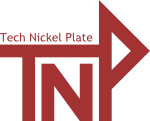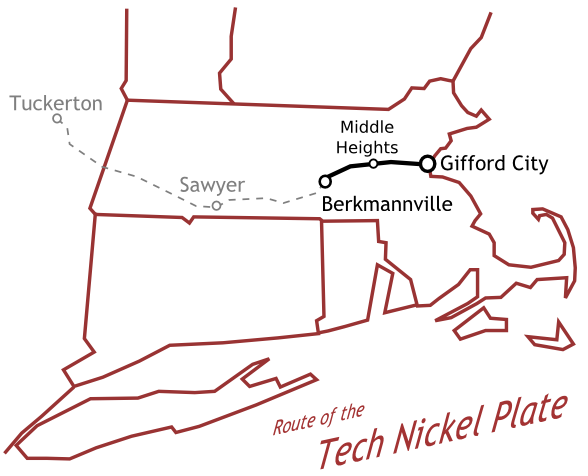|
|


The Tech Nickel Plate Railroad is the club's fictional railroad. The name is a play on the nickname of the New York, Chicago & St. Louis Railroad Company, more commonly referred to as the "Nickel Plate Road", and the word technical. The route of the railroad loosely resembles that of the Boston and Albany Railroard, which ran, predictably enough, from Boston to Albany. We do not, however, model any specific railroad, cities, or time period. Rather, the TNP is intended to represent a typical class I railroad in New England some time from just after the end of the steam era to today.

The layout, our model of the TNP, is, and will probably always be, a work in progress. The layout is a shelf type system, and although the track twists and turns to fit into the room, from a logical perspective the mainline track runs in a straight line from "East" to "West", with sidings and yards built alongside. While the mainline is fairly long (about 300 feet), the scenery is relativly shallow, typically less than two feet from front to back. Since the whole layout cannot be seen from any one place, the layout is designed so that operators walk around, following their trains. This style of operation is thus called "walkaround control" and has become the norm for serious model railroading in the last few decades. To make this possible, the control boxes or "cabs" which operators use to drive the trains can be plugged in at numerous points around the layout. We are also considering radio-linked cabs.
The layout starts at a large east coast city, called Gifford City (named for the club's first advisor). At the eastern end of Gifford City, the tracks connect to the staging yard, which can be used to represent connections to areas north of Gifford City. Loosely based on Boston and Cambridge, the model of GIfford City includes a major passenger station (plus two smaller passenger termainals) to service long-distance and commuter trains, residential, industrial, and commercial areas. It is served by a streetcar line named MITCo, which includes authentically hung overhead wire. There are also a few sidings to service such industries as a cola manufacturer, vegetable oil plant, newpaper, fruit/vegetable distributor and some light industry. On the western edge of Gifford City are an engine servicing facility and small freight yard. One special feature of Gifford City is a scale model of MIT's Green Building which serves as a game board for Tetris.
West of the freight yard is a two-turn, descending helix. In the middle of the helix is a small suburban area, called Middle Heights, home to two industrial sidings and a small passenger station.
At the bottom of the helix, the railroad crosses a deep valley on a stone arch bridge before entering Berkmannville, location of the last two commuter rail stations. A number of industries are located in Berkmannville, including a chemical plant, lumber yard, paper company and a team track. The mainline is double-track between Berkmannville and Gifford City. Three tracks exit the west end of Berkmannville. Two of these are the mainline tracks that enter an ascending helix. Someday this helix will connect to an upper deck (which has not been built, or entirely planned yet). One of the helix tracks also connects to the staging yard. The third track fron Berkmannville connects to the staging yard, and may also be used to represent a branchline during operating sessions.
The staging yard, which contains no scenery, is intended to serve as a place for long-distance trains to begin and end their runs. This would include passenger trains from north of Gifford City and freight trains originating from or going to other railroads. Staging is also a place to store and repair rolling stock. Our staging yard is a "dogbone type" layout all on its own, with reversing loops at each end. This gives each train that enters the option of returning in the opposite direction, or continuously looping in the same direction.
Although firm plans have not been made yet, and probably won't be made for some time, the general concept is for the upper level to include two more cities, Sawyer, a small mountain town with long-distance passenger service, and Tuckerton (named for the club's second advisor), a major city with passenger and freight stations. Unlike the first level, the upper levels will be mostly single-track with passing sidings. Similarly, the lower level is mostly urban, so the upper level, when built, is likely to have a more "rural" feel.
The layout diagram in this section shows the tracks that have been built in the first level of the layout. This includes a double-track mainline loop (which is especially useful for open houses.) The colors of the tracks in the diagram indicate the height of the tracks, with black being highest, magenta lowest, and green in the middle. Tracks in Gifford City are black on the diagram; most of the planned trackwork in Gifford City is complete, except for a siding or two, and most of the downtown scenery is complete. Some scenery remains to be completed, especially near the freight yard. Middle Heights trackwork is in green on the diagram; all of this track is complete and the scenery is about half finished. All the magenta track on the diagram is in Berkmanville; several sidings remain to be finished in this area, and there is much scenery to complete. Finally, the tracks in the staging yard are all in shown in green; this area has no scenery. The helix leading to the upper level will be at the "outboard" end of the staging yard.
The rough relation beween modeled locations and the real world can be seen in the figure below. We generally try to match the geography and structures in an area to something that would be appropriate in the corresponding real world locations. Portions of the line in black have been built, portions in grey are still in the planning stage.

Most of the track at TMRC is hand-laid. This involves cutting and gluing ties to a piece of roadbed, and spiking the rail down with tiny little spikes. It is a bit tedious, but produces very nice looking track that works well. Mainline track is generally Code 83 (except for some sections of Code 100 preserved from the old layout). Sidings and yard-tracks are laid with Code 70. Turnouts are made in the same way. Hidden track (tunnels, helices, and so on) and the staging yard are built with flex-track.
Layout Photo Tours
Here are some photographic tours of our layout, taken around the times of our open houses so you can even see some evidence of progress (there is still lots to do though). The pictures are arranged from east to west like the real railroad. Adjacent pictures (usually) represent adjacent parts of the layout.
Tours:
|
Tech Model Railroad Club of
MIT Room N52-118 265 Massachusetts Avenue Cambridge, MA 02139
|
+1 617 253-3269 Email: tmrc-web@mit.edu |